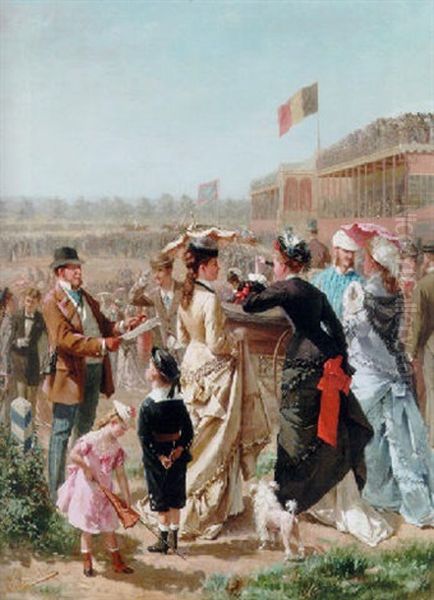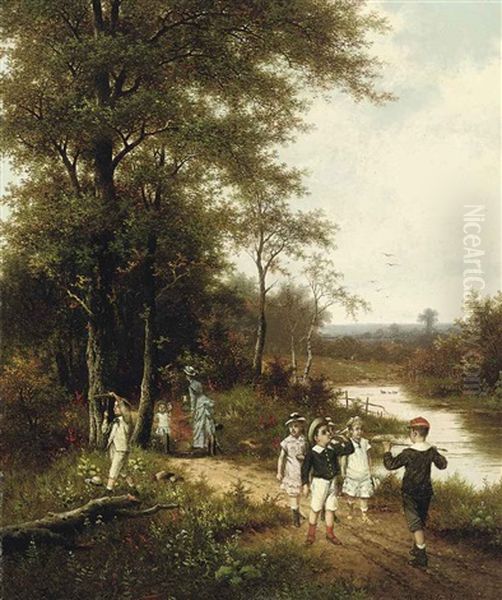The 19th century was a period of profound transformation in European art, a time when artists navigated the currents of Romanticism, Realism, and the burgeoning avant-garde movements. Within this dynamic landscape, Belgian art carved out its own distinct identity, often blending a rich historical artistic heritage with contemporary concerns. Among the figures who contributed to this vibrant scene was Albert Roosenboom, a painter whose work, though perhaps not as globally renowned as some of his contemporaries, offers a captivating window into the social fabric and artistic sensibilities of his time. Born in Brussels, Roosenboom emerged as a significant talent within the Flemish School, specializing in genre scenes, landscapes, and figure painting, leaving behind a legacy of works that charm with their intimacy and keen observation.
Early Life and Artistic Formation in Brussels
Albert Roosenboom was born in Brussels in 1845, a city that was then a burgeoning center for artistic activity, benefiting from Belgium's recent independence and its desire to foster a national cultural identity. His artistic inclinations led him to seek formal training, and he became a pupil of Constantin Meunier (1831-1905). This tutelage was undoubtedly formative. Meunier himself was a versatile artist – a sculptor, painter, and printmaker – who would later become celebrated for his powerful depictions of industrial laborers and miners, embodying a form of social realism.
Meunier's artistic philosophy, which advocated for "expressing painting solely through the harmony of line, volume, and color," likely resonated with the young Roosenboom. This emphasis on the fundamental elements of visual art, rather than overt narrative or allegorical complexity, would have provided a strong foundation for Roosenboom's developing style. While Roosenboom's subject matter would often differ from Meunier's later focus on the working class, the principles of careful composition and chromatic harmony learned under his master would remain evident in his work. His early development in Brussels placed him at the heart of a rich artistic environment, where academic traditions coexisted with newer, more realist impulses.
The Flemish Tradition and the Rise of Realism

Roosenboom is rightly categorized as belonging to the Flemish School. This term, while broad, often refers to artists from the Flemish-speaking regions of Belgium who continued, in various ways, the rich legacy of Netherlandish art. Historically, Flemish art was renowned for its meticulous detail, rich color, and often, its focus on genre scenes – depictions of everyday life. Artists like Pieter Bruegel the Elder and David Teniers the Younger had, centuries earlier, established a powerful tradition of observing and recording the lives of ordinary people.
In the 19th century, this tradition found new expression through the lens of Realism. Realism, as an artistic movement, emerged in France around the mid-1800s, championed by artists like Gustave Courbet, and quickly spread across Europe. It was a reaction against the idealized subjects of Romanticism and the stilted conventions of academic art. Realists sought to depict the world as it was, without embellishment, focusing on contemporary life, social issues, and the experiences of all classes. In Belgium, Realism took on its own distinct character, often infused with a sense of intimacy and a focus on domesticity, which perfectly suited Roosenboom's inclinations. His work aligns with this movement's desire to capture the "here and now," presenting unvarnished, though often charming, glimpses of 19th-century life.
Themes and Subjects: The Intimate World of Albert Roosenboom
Albert Roosenboom's oeuvre is particularly noted for its focus on interior scenes, often populated by figures from the middle class, and especially children. These subjects allowed him to explore the nuances of domestic life, capturing moments of play, learning, quiet contemplation, and familial interaction. His paintings frequently depict well-appointed rooms, providing valuable visual information about the interior decoration, fashion, and social customs of the period.
Children were a recurring and beloved theme in Roosenboom's art. He portrayed them with a sensitivity and understanding that avoided sentimentality, instead capturing their natural exuberance, curiosity, and sometimes, their solemnity. These depictions range from children engaged in musical pursuits, as seen in one of his notable works, to quieter moments of play or study. This focus on childhood reflects a broader 19th-century interest in the world of children, who were increasingly seen as distinct individuals with their own experiences, rather than merely miniature adults.
Beyond domestic interiors, Roosenboom also painted landscapes and other social scenes. His work often demonstrates a keen eye for the subtleties of human interaction and the atmosphere of a place. Whether depicting a lively outdoor gathering or a quiet moment indoors, his paintings convey a sense of immediacy and authenticity. He was an observer of modern life, capturing its textures and moods with a delicate touch.
Key Works and Stylistic Hallmarks

Several works stand out in Albert Roosenboom's oeuvre, illustrating his characteristic style and thematic concerns. One such painting is "Les enfants musiciens" (The Musical Children or Children Playing Music). This work exemplifies his skill in depicting children engaged in everyday activities, capturing their concentration and the joy of making music. The composition would likely feature careful attention to the details of the instruments, the children's attire, and the domestic setting, all rendered with a balanced use of color and light.
Another significant piece mentioned is "Elegant Company at the Races." This painting showcases a different facet of Roosenboom's talent: his ability to depict larger social gatherings and the fashionable society of his time. Such a scene would have allowed him to explore the dynamics of public life, the elegance of contemporary dress, and the vibrant atmosphere of a popular social event. The depiction of "elegant company" suggests a focus on the bourgeoisie or aristocracy, highlighting their leisure activities and social rituals. This work underscores his engagement with the broader social world beyond the confines of the home.
A particularly interesting work is "The River Patrol," which he co-created with Hendrik Pieter Koekkoek (1843-c.1890/95). Hendrik Pieter was part of the renowned Koekkoek dynasty of Dutch painters, known primarily for their landscapes and marine scenes. This collaboration suggests a shared artistic vision or a complementary blending of skills, perhaps with Koekkoek focusing on the landscape or riverine elements and Roosenboom contributing the figures. Such collaborations were not uncommon in the 19th century and often resulted in works that combined the strengths of multiple artists.
Stylistically, Roosenboom's paintings are characterized by their realistic rendering, careful attention to detail, and harmonious color palettes. Influenced by Meunier's teachings, he would have strived for a balance of line, volume, and color. His brushwork was likely controlled yet expressive enough to convey texture and form effectively. Light plays a crucial role in his interiors, often used to create a warm, inviting atmosphere or to highlight specific figures or objects within the composition. His commitment to realism meant that his figures were believable and their emotions subtly conveyed, drawing the viewer into the depicted scene.
Exhibitions, Recognition, and Artistic Milieu
Albert Roosenboom's talent did not go unnoticed during his lifetime. His works were exhibited in prominent artistic centers, including Brussels and Ghent in his native Belgium, as well as in London. Participation in such exhibitions was crucial for an artist's career in the 19th century, providing opportunities for sales, commissions, and critical recognition. The fact that his work was shown in London indicates a degree of international appeal.
He was active during a vibrant period in Belgian art. The mid-to-late 19th century saw the rise of significant Belgian artists who explored various facets of Realism and other emerging styles. His teacher, Constantin Meunier, would go on to achieve great fame for his depictions of industrial life. Other notable Belgian contemporaries included Alfred Stevens (1823-1906), who gained international acclaim for his elegant portrayals of Parisian society women, and Henri de Braekeleer (1840-1888), known for his meticulously detailed and atmospheric Antwerp interiors, which share some thematic similarities with Roosenboom's focus on domestic scenes.
Charles Hermans (1839-1924) was another key figure, whose monumental painting "À l'Aube" (At Dawn) caused a sensation with its realistic depiction of working-class revelers after a night out, highlighting social contrasts. Jan Verhas (1834-1896) was celebrated for his charming scenes of children, particularly his depictions of the Belgian royal children and lively beach scenes at Ostend. David Col (1822-1900) and Joseph Stevens (1816-1892), the latter known for his empathetic paintings of dogs, also contributed to the rich tapestry of Belgian genre painting. The portraitist Lievin De Winne (1821-1880) captured the likenesses of many prominent figures of the era.
The artistic environment was further stimulated by groups like the Société Libre des Beaux-Arts, founded in Brussels in 1868, which promoted artistic freedom and realism, challenging the dominance of the official Salon. While Roosenboom's direct involvement with such groups requires more specific research, he operated within this milieu of artistic debate and innovation. The influence of French Realists like Gustave Courbet (1819-1877) and Jean-François Millet (1814-1875) was also palpable across Europe, encouraging artists to turn their attention to the realities of contemporary life. Even the more Symbolist-inclined Félicien Rops (1833-1898) was a contemporary, showcasing the diversity of Belgian art.
A Note on Names: Distinguishing Albert Roosenboom
It is important to distinguish Albert Roosenboom, the Belgian painter (1845-c.1873/75), from another artist with a similar name, Nicolaas Johannes Roosenboom (1805-1880). Nicolaas Johannes was a Dutch painter, primarily known for his Romantic landscapes, especially winter scenes. He was a student and son-in-law of the famous Dutch landscape painter Andreas Schelfhout (1787-1870). Some sources might inadvertently conflate details between these two artists due to the similarity in their surnames.
For instance, the connection to Andreas Schelfhout as a teacher or father-in-law, and the tutelage of artists like Frederik Marinus Kruseman (1816-1882), pertains to Nicolaas Johannes Roosenboom, not Albert. Albert Roosenboom's primary mentor was Constantin Meunier, and his artistic sphere was centered in Brussels and the Belgian Realist movement. The collaboration with Hendrik Pieter Koekkoek on "The River Patrol" is correctly attributed to Albert Roosenboom, as Hendrik Pieter was a contemporary active in a similar timeframe. Other Dutch painters mentioned in some contexts, such as Jan Jozua Broodema (active 19th c.), Charles Rochussen (1814-1894), and Tiburt Reggers (1848-1899), were contemporaries in the broader sense but belong more to the Dutch artistic sphere, which, while related, had its own distinct characteristics. The great animal painter Eugène Verboeckhoven (1798-1881), though Belgian and highly influential, represents an earlier generation but his long career overlapped with Roosenboom's.
Later Years and Legacy
Albert Roosenboom's career, though impactful, was relatively short. He is recorded as having moved to Paris, the undisputed art capital of Europe at the time, where he continued his artistic pursuits. Sadly, he passed away at a young age, around 1873 or 1875 (sources vary slightly on the exact year). His premature death undoubtedly cut short a promising career.
Despite his relatively brief lifespan, Albert Roosenboom left a valuable contribution to 19th-century Belgian art. His paintings serve as charming and insightful documents of his time, capturing the nuances of middle-class life, the world of children, and the prevailing social customs. His work is appreciated for its technical skill, its sensitive portrayal of human subjects, and its adherence to the Realist ethos of depicting the contemporary world with honesty and empathy.
His paintings continue to be valued by collectors and art historians for their aesthetic appeal and as historical records. They offer a glimpse into the private lives and public spaces of 19th-century Belgium, rendered with a warmth and sincerity that remains engaging. While he may not have achieved the revolutionary status of some of his avant-garde contemporaries, Albert Roosenboom's dedication to his craft and his insightful portrayals of everyday life secure his place as a noteworthy figure within the Flemish School and the broader movement of 19th-century European Realism. His art reminds us of the importance of those painters who, with skill and quiet dedication, chronicled the world around them, leaving behind a legacy of beauty and truth.